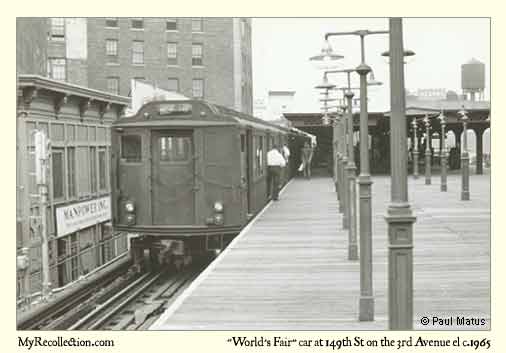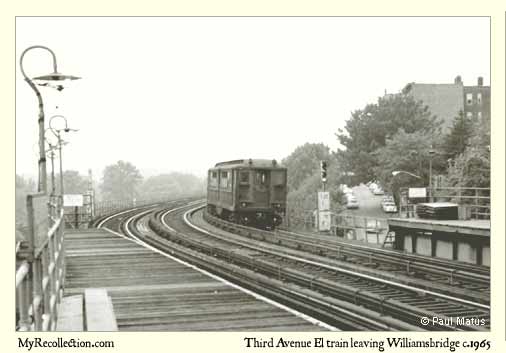

Riding the High Tracks
The Bronx Remnant of the Third Avenue El

It all began in those far-off days of horse-drawn carriages and coaches, gaslight lamps and cobblestone streets, top hats and parasols. Rapid Transit needed to alleviate the congested streets of Manhattan. One solution adopted by the city was the construction of overhead railways. Eventually four elevated lines were built covering the East and West sides of the island. The Second, Third, Sixth and Ninth Avenue elevated lines were born. Beginning with a single track up Ninth Avenue in 1868 all the lines eventually became triple track lines by 1916; the middle track for express trains.
The Third Avenue Line opened August 26, 1878 running up the avenue, built in stages till it reached into the Bronx in 1886. After decades of service the els were considered obsolete and demolition began in favor of subways. The section of the Third Avenue from Chatham Sq., near City Hall to just below 149th Street in the Bronx was torn down beginning May 12, 1955. The final segment in the Bronx, from 149th to Gun Hill Road finally met its demise on April 29th 1973. The end of an era that had lasted almost one hundred years.
These dates have special meaning for me. From its heyday to its inevitable ending, the Third Avenue El served the city and the borough of the Bronx with dependable; vital transportation. It ran through the spine of the Bronx; Mott Haven, The Hub, Melrose, Morrisania, Bathgate, Tremont, Belmont, Fordham, up Webster Ave. through Bedford Park to its terminus at Gun Hill Road. It was a workhorse carrying people to and from work, recreation and other daily activities, opening neighborhoods to commerce and development. It was a link to our glorious past.
I was always fascinated by the elevated railway. I even constructed a scale model using my Erector Set and Tinker Toys, running my Lionel Trains over a propped-up version of the line! With an imaginary third-rail I'd operate those trains like the regular engineer, stopping at stations to pick up passengers. I often wondered how a five-car train could be supported by such an insubstantial-looking structure. It appeared to be a skeleton laid bare resting upon thin girders. It must be a deception of engineering know-how I thought. As a boy I took many trips on the el, entering the 183rd Street station, just a short walk from my apartment building on 184th Street and Washington Avenue. I accompanied my parents on those occasions. One day in 1956 I decided to venture on my own.
 I had no particular destination, but paid my fare of 15 cents and headed right for the first car to stand beside the operator's cabin. This was a five- car train with the Low V type cars accommodating a center door. I would stare intently out the front door window as the train made its way downtown. I felt the freedom and excitement of zipping along over the streets. I was transfixed; absorbing all the sights along the route.... the stone and brick canyons, the noise echoing off the buildings. I liken it now to a description I read by William Dean Howell in his "Hazard of New Fortune" (1890). "...fleeting intimacy you formed with people in the second-and-third floor interiors." He was referring to the apartment windows where one could glimpse a "fleeting" moment as you passed. Perhaps you would see someone sitting at a kitchen table or walking through the living room or maybe leaning out the window watching the train pass by. This was a connection. You could share a moment of their lives.
I had no particular destination, but paid my fare of 15 cents and headed right for the first car to stand beside the operator's cabin. This was a five- car train with the Low V type cars accommodating a center door. I would stare intently out the front door window as the train made its way downtown. I felt the freedom and excitement of zipping along over the streets. I was transfixed; absorbing all the sights along the route.... the stone and brick canyons, the noise echoing off the buildings. I liken it now to a description I read by William Dean Howell in his "Hazard of New Fortune" (1890). "...fleeting intimacy you formed with people in the second-and-third floor interiors." He was referring to the apartment windows where one could glimpse a "fleeting" moment as you passed. Perhaps you would see someone sitting at a kitchen table or walking through the living room or maybe leaning out the window watching the train pass by. This was a connection. You could share a moment of their lives.
When I reached 149th Street which was the last stop, I simply took the train back up the line and my adventure continued. The stations at Tremont and Fordham were once express stops having double wooden platforms. These platforms were exposed with no railings. It seems to me that any sudden gust of wind or a false step would send a person dashing to the tracks! At nine years old my imaginary fears were real enough. As we continued uptown we passed the Sears Roebuck Tower on the left and curved up Webster passed Fordham University on the right continuing on to see French Charlie's Field and the Botanical Gardens off to the right near 204th Street. As the trip ended we turned at a right angle over the Bronx River Parkway to the terminus at Gun Hill Road. Making the connection to the White Plains Road Line. At one time in the distant past the Third Ave El shared the same tracks with the White Plains Road line and continued up to the last stop at 241st Street. But this was the end of the line. After a short while the train began its run downtown again to 183rd Street and home.
My parents had no idea of my whereabouts or what I was up to. My father worked the night shift at Bond Bread and slept during the day. My mother worked at Joe Vin Blouse Company on 187th Street in Belmont. When she got home around 4 pm and didn't find me in the apartment, she naturally woke up my father. He thought I was playing in the street below. Well, I must have timed it perfectly because it was just about this time I walked through the front door and saved the local police precinct from a wild goose chase! I got more than just a bawling-out from my parents, but it still didn't deter me from riding my beloved train. I had many more future escapades alone and with friends.
A classmate of mine lived on the corner of 183rd Street and Third Avenue in a second floor apartment facing the el. You could reach out and touch the catwalk from his kitchen window. I was in his house many times and neither he nor his family ever complained of the noise or thunderous vibrations as the trains continuously rumbled past. The trains always came to a screeching halt because the station was at this corner. You have to imagine what it was like. Take that imaginary trip on the elevated. It may have been a relic even in its day, but the nostalgia perks up every time it comes to mind. Like some aging matron, it creaked and groaned with the aches and pains of old age. Late in the 1960's the city was forced to place governors on the wheels of all the trains on the Third Ave el to regulate the speed. I suppose the city fathers were afraid the structure would collapse! One engineering marvel I recall was during the construction of the Cross-Bronx Expressway in the 50's and early 60's it was necessary to raise the el above this elevated highway to accommodate the height of the tractor- trailers. It was truly amazing to see the construction workers slowly create a steel trellis without interrupting service. But the end was coming, plain as day, and it was just as amazing to see the swift razing of the el.
Why all the fuss over what many people consider a rickety, noisy, grimy eyesore? To my mind it was part of our heritage, our history. The el was a national treasure; a magnificent feat of engineering and design. The el was part of the neighborhood, like arteries pumping the life-blood of people on the move. Even with its rattles and screeches the elevated had special charm, from its gingerbread style stations and stain glass windows to its quaint pot-bellied stoves and wooden turnstiles. The skeletal structure cast its mysterious shadows; a criss-cross, spider web pattern to the cobblestone street below. Mysterious indeed; dark and menacing! It was complemented by the buildings along the route distinctive in their appearance with brick and ornate masonry, fire escapes, signs on the stores, water tanks on the roofs, and of course the cast-iron Bishop's crooks lampposts lining the sidewalks. The atmosphere was complete. Think of a detective yarn or a dark, brooding plot from a film noir and the stage is set. It is a street scene with character, with a personality all its own; a Bronx scene. It is gone, lost from us through the cruel fates of time. But it is preserved in memory, film, photography, prints and drawings. The elevated, once a symbol of progress, has passed into history.
During the 1940's there was a Bronx Community protest with a flyer that tried to arouse opposition to the second Avenue el's demolition. The razing of that line would have put extra burdens on the Third Avenue Line.
DON'T CRAB NEXT MONTH WHEN
TRAVEL DOWNTOWN BECOMES
UNBEARABLE...ACT NOW
ATTEND MASS MEETING
PROTESTING PROPOSED
DEMOLITION OF SECOND AVENUE AND
NINTH AVENUE ELS AT MORRIS
HIGH SCHOOL--YOU MUST DO
YOUR SHARE!(Source: Fallen Transit: The Loss of Rapid Transit
On New York's Second Avenue by Alexander Nobler Cohen..
The Third Rail Online (www.3drail.com) )
This availed no one and we all know the fate of the Second and Ninth Avenue els. It just took a little longer for the destruction of the Third Avenue Line. There had been another attempt by the Bronx Chamber of Commerce and other organizations to try and block the demolition, but it did not have the support of civic organizations and the property owners. Many thought the el was an urban blight; an unpleasant nuisance to be torn down for what they thought would be revitalization and redevelopment of the corridor. The supporters for keeping the el failed to convince city officials of the need to preserve it. Instead of revitalization, the neighborhoods declined and became rife with crime, deterioration and poverty. It is only now that the area is coming back to economic and social health.
That stretch of the Third Avenue El, the last remnant, was finally dismantled and replaced not with a subway, but with the Bx55x Bus. And so it was that fateful day April 29th 1973, the last train made its run and one more vestige of Old New York faded away and another link to our past forever destroyed.
Gregory J. Christiano
gregoryc@myrecollection.com

info@myrecollection.com
©2002 MyRecollection.com. and Gregory J. Christiano